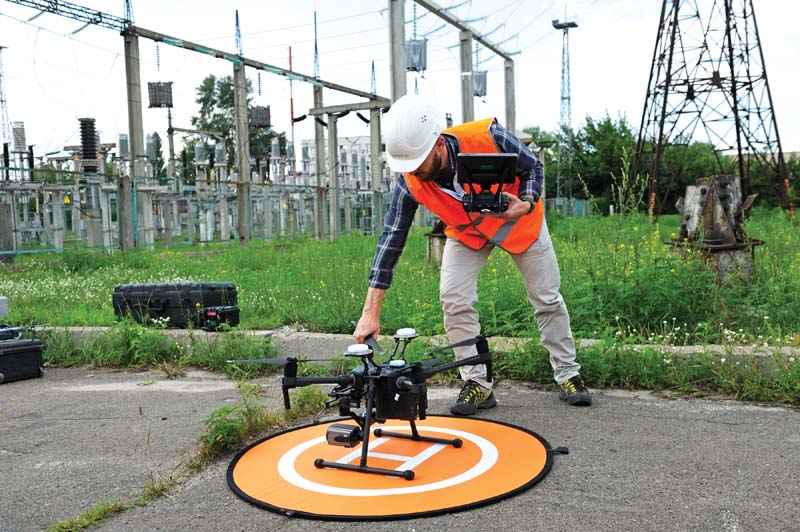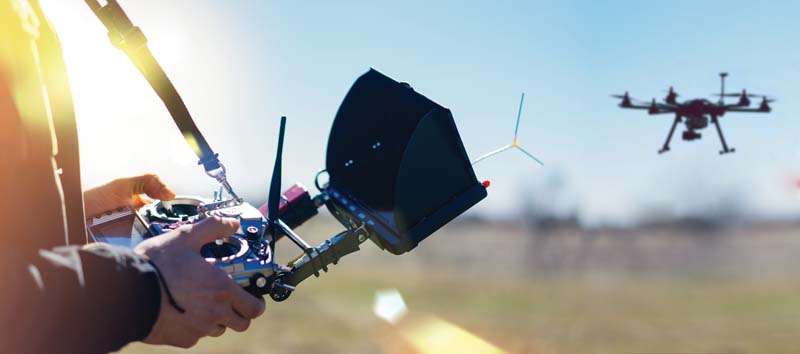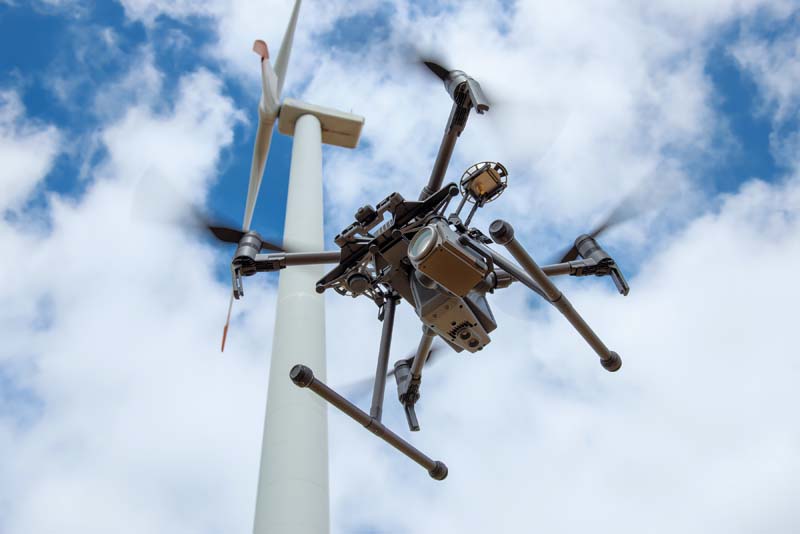Gaining buy-in from your executive team is an essential first step that can make or break any company’s drone program. While a boots on the ground professional or a business manager is interested in new use cases, increased efficiency, hiring pilots, and processing data, your executives may not care about any of those things until you can prove the drones won’t increase your company’s liability. Your compliance and legal teams may be most concerned about ensuring that your flight crews will never violate airspace regulations, damage infrastructure, or infringe on privacy. As a customer success manager at Skyward, I have helped many businesses reinforce best practices for drone adoption and management, and I share some of my best tips for success in this article.
At any complex organization, there are many different stakeholders with diverse goals any time new technology is introduced, and drones are a prime example. Your legal team, your finance team, and your executives will all have different concerns. If you can address those concerns in advance, you’ll have a smoother path to success. There’s no harm in making your bosses look good, and you’ll have a much easier time getting budget if you have a good relationship with your finance team. Jumping through so many hoops can feel time-consuming, especially if you already have projects lined up, but it’s essential to build trust with all your stakeholders from the very beginning.
Drones are constantly in the news these days, so your executive team may already know about what’s going on with them and have an idea of the industry-specific value they could provide to your company or agency. Be smart about the use case that you select for your pilot program. You want something that’s simple, straightforward, and that you feel very confident will save money, make money, or both. Start by describing the business problem the drones will solve. For example, stockpile volume metrics are inaccurate or substations take months to inspect. Then show how drones can provide a viable solution. When possible, provide third-party case studies and reports from other companies, universities, or professional services firms. Remember to include data about how drones will help increase revenue, cut costs, or both. And if you need help with any of that, you can engage with Skyward’s team of experts to assist.

MAKING THE CASE FOR DRONES
1. Show your executives how drones will make money, save money, lower risks, or give your company access to entirely new data streams.
2. Start small: select an initial use case that is sure to provide solid returns.
3. Work with your finance team to ensure you have the necessary budget.
4. Report back to your executive sponsor with metrics and deliverables they can then share with their bosses.
5. Show that you have a plan in place to mitigate risks and standardize procedures; this will instill confidence.
PITFALL TO AVOID:
Assuming your executives already understand the value that drones can provide your company.

Your Company’s Drone Training Program
So as I’m sure most of our audience knows, all pilots flying commercially under Part 107 in the United States need to pass the knowledge exam at an improved test center. But that’s really just the beginning. The goal of any training program isn’t to check a box or pass a test. It’s to foster a self-reinforcing culture of safety within the company’s drone program. Just passing the exam isn’t necessarily a sign that a pilot is highly proficient. For example, you can actually pass that test without ever having piloted a drone before. The test simply shows that an operator has a good idea of what’s going on with the regulations. Even highly proficient pilots may have slightly different takes on how to do things. It’s important to take some time and set training milestones, specific to your company and your use cases. It’s incumbent on every company to ensure their pilots are following standardized procedures and that they’re not going rogue.
And that brings us to hiring. So you see a pilot has a good resume, all of the qualifications, and tons of experience. You should probably hire that person, but don’t assume that your company is off the hook. Your flight crews still need a standardized way to work together to communicate and to make sure that they’re collecting the data that is really the point of flying drones in the first place. Skyward’s expert trainers are adept at classroom and flight training, as well as customizing our general operating manual and checklist for our customers. The point of all that training is to have a low risk, high reward drone program that operates at maximum efficiency.
TRAINING TIPS
6. Create your own internal requirements for knowledge tests and flight exercise tests specific to your company policies.
7. The FAA recommends 20 hours of study to pass the Part 107 Knowledge Exam. Find a study buddy!
8. Send your personnel without aviation backgrounds to an online or in-person ground school specific to drones.
9. Master multirotor orientation with a deliberate set of milestones.
10. Standardize your pilot training program
PITFALL TO AVOID:
Hiring experienced drone pilots with Part 107 certifications without providing standardized training, policies, and procedures.

Worksite Efficiency Practices
The best flight processes increase efficiency, lower costs, mitigate risks, and empower your crew to do their best work. I’ve learned so many cool tips to increase on-site efficiency and some of them are pretty obvious, like verifying that you’ve collected the data that you need before you pack up for the day. Some are kind of surprising, like to bring your own shade. It’s so simple, but nothing can stall an operation faster than the pilot not being to see the ground control station or standing out there and baking in the sun and just overheating. It’s also important to set up cones or markers to keep passersby away and show that you’re flying on official business. On-site efficiency is so important that we’ve included twice as many tips. Always plan your flight ops in advance. The Skyward airspace map is great for that. One of the most common reasons companies first go to Skyward is to get pre-flight intelligence both on the ground and in the air. No matter how much experience pilots have, they don’t have any way of knowing if a temporary flight restriction is in place or what class the airspace is without checking an airspace map. At Skyward, we’re particularly proud that our program also includes heights of over a million key structures, transmission lines, and pedestrian paths, all of which are essential. And of course, you can use it to gain fast access to control the airspace via the FAA’s LAANC program.
One last tip: always, always, always bring a backup aircraft, batteries, and memory card—especially if you’re operating at any amount of distance away from your headquarters. That’s bound to save you both time and money.
ON-SITE EFFICIENCY TIPS
11. If the flight job location or product requirements are unusual, conduct an on-site assessment prior to accepting work.
12. Check and verify you collected the necessary data before shutting down.
13. BYOS: Bring your own shade: It can be hard to see the ground-control station or tablet on a bright day.
14. Set up cones or markers to keep passers by from wandering into your flight area.
15. A general operating manual and checklists are the foundation of every UAS program.
16. Plan operations in the office before you arrive on site to maximize on site efficiency.
17. Choose a minimum distance the ground-control station should be from a visually blocking structure.
18. Conduct an initial obstruction height check if precise information on hazard height in the area isn’t available.
19. Always have a backup aircraft and extra batteries. Field repairs are difficult and nobody wants a job delay just because they ran out of batteries.
20. Complete pre-flight checks on all aircraft before the first flight at each job site.
PITFALL TO AVOID:
Going into the field without detailed knowledge of your flight area, from 400 to 0 feet above ground level.
Risk Mitigation
So recently I was talking to a customer at a large engineering firm and he said, “You’re always just one mistake away from having your entire operation shut down.” That really points to the connection between operations management and safety. A well-managed operation is safe by definition, and a safe operation tends to be very well-managed.
As a Verizon company, we at Skyward understand very well that every company has different requirements for managing safety and risk. That’s why it’s so important to build a positive, ongoing relationship with your risk management team. It’s a relationship that requires trust, which must be constantly earned. A great way to build trust is to demonstrate how drones can actually decrease a company’s net risk, for example, by reducing the time workers spend on roofs, scaffolding, and towers.
Keep really thorough records. You’ll show you have nothing to hide and that you’re committed to checking all the boxes. Of course, we always recommend giving any stakeholder access to the drone operations management platform you use. With Skyward, for example, stakeholders can see if pilot credentials are up to date as well what the jobs have been flown and whether everyone stayed within Part 107 regulations during their flights.
Every company will have different standards and risk thresholds, and every pilot may have a slightly different interpretation. So it’s important that everyone is on the same page. One way to do that in Skyward is using our customizable checklists to standardize procedures across the company.

Skyward’s Live Flights feature allows companies to monitor drone flights from anywhere. It is also the foundation for Skyward’s implementation of Remote ID.
RISK MITIGATION TIPS
21. Build a positive ongoing relationship with your risk management team. You will continue to have conversations with them as the technology changes and your use cases expand.
22. Use any existing data to show your risk management team that drones may decrease the company’s net risk.
23. Work with experts to adapt a General Operating Manual and Standard Operating Procedures to include corporate policies.
24. Give your stakeholders access to your drone management platform for full transparency.
25. Have a thorough maintenance plan and keep detailed maintenance logs.
PITFALL TO AVOID:
Leaving risk mitigation to each pilot’s best judgment.

Future-Proofing
One of my favorite things about working in Skyward is helping our customers test cutting-edge technology through our aviation development centers. There are always new developments with drones and sensors and to maintain a competitive advantage, you’ll want to have a plan to adopt and use that new tech.
The most important tip for new tech is to have a defined business case before you adopt it. At Skyward, we talk a lot about connecting drones to the Verizon network to enable artificial intelligence beyond visual line of sight flights and autonomous flights, but not every company may have a need for those things. You also need to have a way to securely store the additional data and retrieve it. Otherwise there’s no point in having it.
As your operation scales up, you’ll find it increasingly important to have an easy-to-use system to manage the details of your drone program, especially as you start coordinating multiple jobs in separate locations with different flight crews and managers. You’ll want to know that every crew was following the same processes, that aircraft are being maintained to the same sets of standards, and that everyone follows internal procedures as well as airspace rules. Using a drone management platform like Skyward that includes airspace intelligence can help ensure that standardized procedures are being followed, provide an audit trail to evaluate pilot safety, provide efficient access to airspace, and serve as a digital system of record.
One of the most common pitfalls we see with new programs is that they invest in a fleet of aircraft before they really know their initial use cases. Buying aircraft can feel like a good first step, but if your primary use case is horizontal infrastructure inspections, you may find that a fixed wing drone is more useful than a quadcopter.
It’s worth thinking about what you’re going to be doing and your initial use cases before selecting aircraft and sensors. We always advise that you fly the smallest, safest drone that you can to get the job done. You may not need a big heavy lifting drone to do something like a vertical infrastructure inspection. So make sure that before you invest in those ways, you’ve gone about recognizing exactly what tools it’s going to take to do your job in the field.
FUTURE-PROOFING TIPS
26. Invest only in what you need: Do you have a business case for artificial intelligence, beyond visual line of sight flights, or autonomy at scale?
27. Have a plan for data use and storage. If you can’t find it or make use of it, the extra high-quality data won’t provide business value.
28. Have strong internal systems, including a complete system of record with personnel, maintenance, and flight records.
29. Ensure you have the data experts at your company to parse the information you collect.
30. Test your near-future-use cases that require connectivity in a controlled environment.
PITFALL TO AVOID:
Investing in aircraft as the first step to starting up a drone operation.
The Takeaway
I hope this discussion, and the 30 tips, will assist you in your journey of adding drones to your company’s assets. We’ve gone over how best to make a case for drones, offered advice for starting a drone operator training program, and looked at worksite efficiencies. Then we discussed ways to mitigate risks and last but not least, future-proof your drone operation so that it can grow with your business. I encourage you to also look into drone management software, like the Skyward platform, that will make your program safer, ensure you’re following regulations, be accessible to company stakeholders, and have a high return on investment. As we like to say here, upward, onward, and Skyward.
By Mike Morris



















